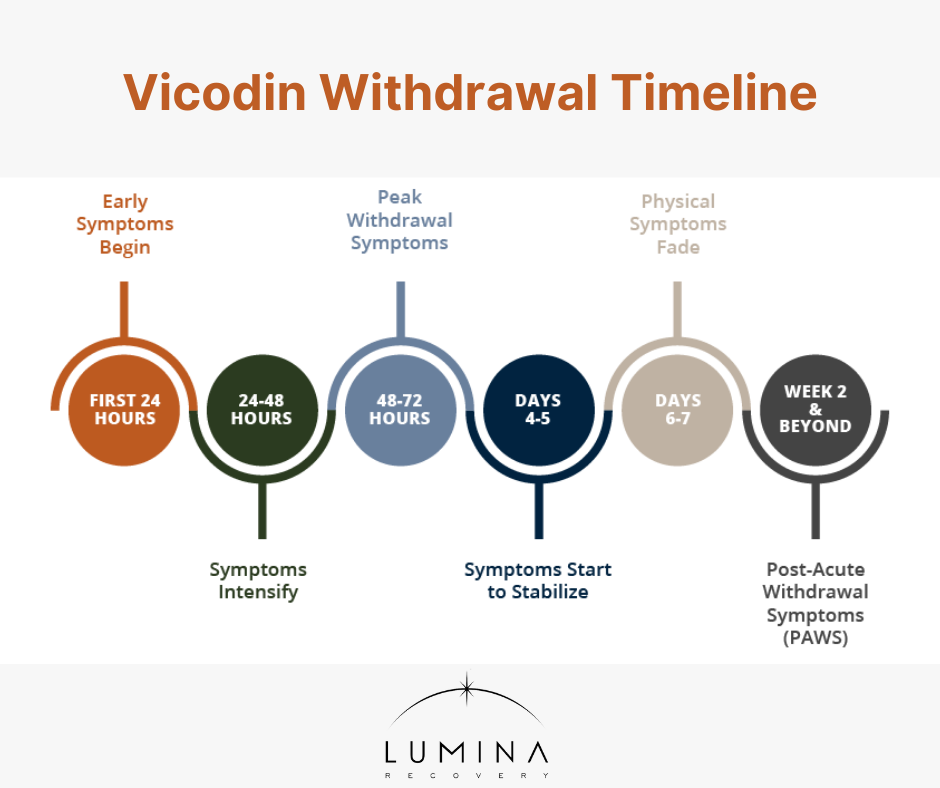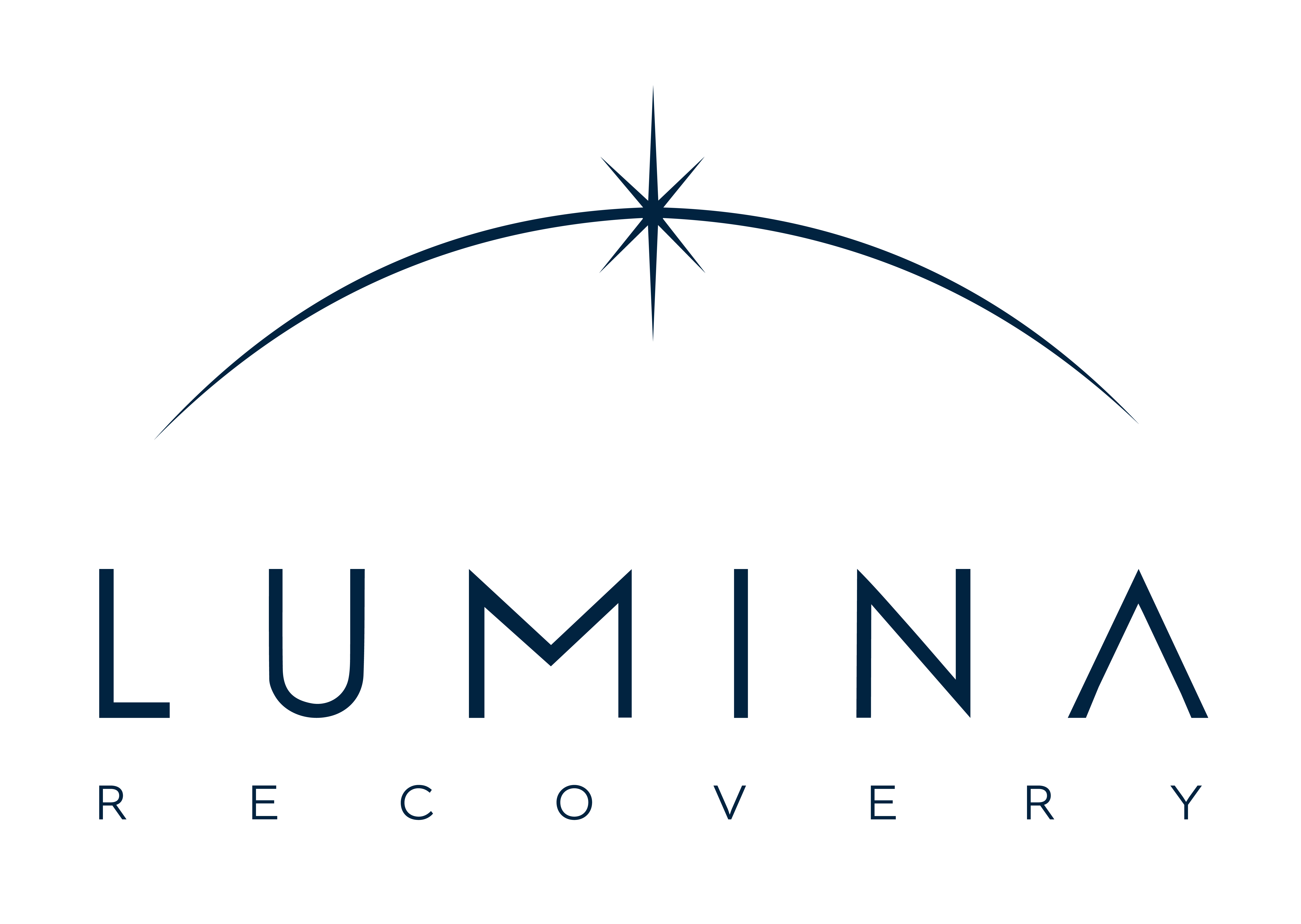Vicodin, a commonly prescribed painkiller combining hydrocodone and acetaminophen, is effective for pain management but carries a significant risk of misuse and addiction. Over time, repeated use of Vicodin can lead to physical dependence and addiction, leading to withdrawal symptoms when the drug use is discontinued.
Understanding Vicodin withdrawal symptoms, the process of detoxification, and the treatment options available are critical for individuals struggling with addiction and their loved ones. Let’s explore the signs and symptoms of Vicodin dependence, the Vicodin withdrawal timeline, the challenges of detox, and the support systems that make recovery possible.
Statistics About Vicodin Use and Abuse
The misuse of prescription opioids, like Vicodin, remains a significant concern in the United States. In 2023, approximately 8.6 million Americans aged 12 and older admitted to misusing prescription opioids within the past year. Among them, over 5 million individuals reported struggling with a prescription use disorder during the same period.1
These alarming numbers underscore the prevalence of Vicodin abuse and other opioid misuse, emphasizing the urgent need for awareness, prevention, and accessible treatment options to combat this growing crisis
What Is Vicodin Withdrawal?
Withdrawal occurs when someone dependent on Vicodin stops or significantly reduces their use. Prolonged Vicodin use alters the brain’s neurotransmitter balance, creating physical and psychological reliance on the drug. When the brain no longer receives Vicodin, withdrawal symptoms set in as the body struggles to regain balance.
Factors Influencing Opioid Withdrawal Severity
- Duration of Use: Prolonged use increases the intensity of Vicodin withdrawal symptoms.
- Dosage: Higher doses of medication amplify hydrocodone withdrawal.
- Health Conditions: Underlying medical or mental health issues can worsen withdrawal.
- Co-Occurring Substance Use: Individuals using multiple substances may experience more severe symptoms.
Expected Symptoms of Vicodin Withdrawal
Withdrawal symptoms of Vicodin addiction can range widely in intensity and duration based on individual factors such as duration of use, higher dose, and the person’s general physical and mental health.2
Physical Symptoms
- Muscle Aches and Joint Pain: Often described as flu-like symptoms, these can range from mild to extremely debilitating.
- Gastrointestinal Distress: This includes nausea, vomiting, diarrhea, and stomach cramps, which are common and can lead to dehydration and nutrient depletion.
- Temperature Regulation Issues: Many experience chills, sweats, and goosebumps as the body struggles to manage its temperature without the influence of Vicodin.
- Increased Heart Rate and Blood Pressure: These symptoms can be particularly dangerous for those with underlying heart conditions.
- Fatigue and Exhaustion: Despite feeling very tired, many people find it difficult to sleep properly during withdrawal.
Psychological Symptoms
- Anxiety and Depression: Withdrawal can exacerbate underlying mental health conditions or trigger new ones.
- Irritability and Mood Swings: Emotional regulation becomes more difficult, leading to sudden changes in mood.
- Cravings: The desire to use Vicodin can be strong and persistent, often triggered by both physical discomfort and psychological stress.
- Disorientation and Confusion: Some individuals may experience a lack of focus or confusion during withdrawal.
- Insomnia and Disturbed Sleep Patterns: Difficulty falling asleep, staying asleep, or experiencing restorative sleep is common.
Vicodin Withdrawal Timeline

The withdrawal from hydrocodone timeline can be a challenging experience, with the amount of time the process takes significantly varying from person to person. It’s important to know the side effects and risk factors for Vicodin withdrawal that individuals might experience at different stages:3
First 24 Hours
- Early symptoms start to appear as the drug begins to leave the system.
- Symptoms may include restlessness, anxiety, muscle aches, and an intense craving for the drug.
- Mild symptoms such as excessive sweating, agitation, headaches, and a runny nose are also common.
24-48 Hours
- Symptoms may begin to intensify. This period can be particularly uncomfortable.
- Common symptoms include increased tearing, yawning, and sweating, as well as insomnia and irritability.
- Gastrointestinal distress may start to occur, manifesting as loss of appetite, stomach cramps, and nausea.
48-72 Hours
- This is often the peak of physical withdrawal symptoms.
- Symptoms can include diarrhea, vomiting, and continued nausea, along with peak levels of muscle aches and possibly abdominal cramping.
- Chills, tremors, and goosebumps are frequent, indicating the body’s struggle to regulate temperature and pain sensation.
Days 4-5
- Symptoms may remain intense but begin to stabilize. While still very uncomfortable, the body starts to adapt to the absence of the drug.
- Physical symptoms like nausea and muscle aches begin to decrease gradually.
- Psychological symptoms can become more pronounced, including anxiety, depression, and continued insomnia.
Days 6-7
- Physical symptoms generally start to subside significantly.
- Emotional and psychological symptoms may persist or increase, such as mood swings and irritability.
- Cravings for Vicodin can remain strong, posing a risk for relapse, particularly if psychological support is not in place.
Week 2 and Beyond
- Most severe physical symptoms should have subsided. However, some individuals might continue to experience extended withdrawal symptoms, referred to as post-acute withdrawal syndrome (PAWS).
- PAWS can include ongoing mood disturbances, fatigue, chronic pain, and irregular sleep patterns.4
- Mental illness support remains crucial, as psychological cravings and emotional instability can go on for weeks or even months after stopping Vicodin.
The hydrocodone withdrawal symptoms timeline mirrors that of Vicodin, as Vicodin contains hydrocodone and affects the brain in a similar way.

The Detox Process
Detox is the first critical step in overcoming addiction. Attempting to withdraw from Vicodin without professional help carries serious risks. A structured Vicodin detox ensures safety and reduces the discomfort associated with withdrawal.
Medical Detox vs. At-Home Detox
Unsupervised withdrawal can be dangerous, increasing the risk of relapse and severe symptoms. Medical detox provides professional monitoring, access to medications, and nutritional support to ease withdrawal.
Medications Used During Detox
Buprenorphine or methadone can help reduce cravings and withdrawal symptoms.
Over-the-counter medications, such as anti-nausea or anti-diarrheal drugs, help manage symptoms.
The Role of Hydration and Nutrition
Proper hydration and a balanced diet support the body’s recovery during detox, addressing physical symptoms like fatigue and nausea.
Treatment and Recovery Options
After detox, comprehensive treatment is necessary to address the root causes of addiction and prevent relapse.
- Inpatient programs offer 24/7 care in a controlled environment, ideal for those with severe addiction or co-occurring mental health disorders. This intensive approach includes therapy, counseling, and medical monitoring.
- Outpatient care, including therapy sessions and support groups, provides flexibility for those balancing work or family obligations.
- Therapies like cognitive behavioral therapy (CBT) and dialectical behavior therapy (DBT) help individuals manage cravings, address underlying issues, and develop coping mechanisms.
- Support groups like Alcoholics Anonymous (AA), Narcotics Anonymous (NA), or other community programs provide ongoing peer support, which is crucial for long-term sobriety.
Frequently Asked Questions (FAQs)
1. How long do Vicodin withdrawals last?
Symptoms typically last one to two weeks, though psychological effects may persist longer.
2. What is the first sign of Vicodin withdrawal?
Early symptoms include sweating, muscle aches, and irritability.
3. What reduces Vicodin withdrawal symptoms?
Medications like methadone, along with hydration and rest, can alleviate symptoms.
Take the First Step Toward Sobriety With Lumina Recovery
Vicodin withdrawal can feel overwhelming, but understanding the opiate withdrawal timeline and seeking professional support can make the journey manageable. The signs and symptoms of Vicodin addiction highlight the importance of structured detox and treatment.
At Lumina Recovery, we specialize in medically assisted detox, ensuring a safe and effective withdrawal process, and dual diagnosis treatment to address underlying mental health conditions that may accompany addiction. Our comprehensive approach builds a solid foundation for lasting recovery.
If you or a loved one is struggling with Vicodin addiction, contact us today to begin the journey toward a healthier, addiction-free life.
Sources:


